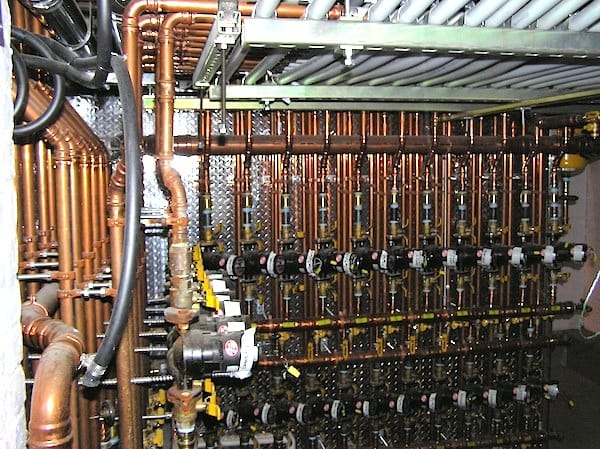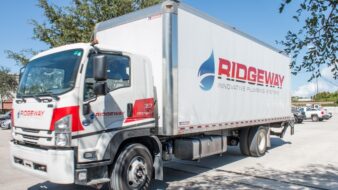As the construction industry moves toward the 2030 goal of net zero energy buildings — buildings that produce as much renewable energy as they consume on an annual basis — HVAC system design is at the forefront of these efforts.
This is especially true for commercial buildings. Given that a standard HVAC system represents 40 percent of a commercial building’s total energy use, there is a tremendous opportunity to adopt HVAC system design that achieves efficiencies in operations and realizes long-term cost savings.
 To maximize energy savings, industry experts today are taking a holistic approach to HVAC system design. Smart designers understand that energy efficient components need to work together as a complete system to achieve the highest efficiencies possible.
To maximize energy savings, industry experts today are taking a holistic approach to HVAC system design. Smart designers understand that energy efficient components need to work together as a complete system to achieve the highest efficiencies possible.
Hydronic systems provide water-based heating and cooling through pipes and other components, such as pumps, drives, controls, heat exchangers chillers and boilers. Rapidly advancing technology and the U.S. Department of Energy’s new pump energy efficiency rule that goes into effect in January 2020 have spurred even greater focus on efficiency by pump manufacturers.
Variable refrigerant flow (VRF) systems are another HVAC option often considered for new and existing buildings, but the potential variation in both energy savings and high initial costs affects the ability to determine the cost effectiveness of the technology for different building types, sizes and locations. VRF systems heat and cool buildings with refrigerant that runs through pipes to individual cassettes throughout the building.
With ever-growing market demand for better energy efficiency, the pros and cons of hydronic and VRF systems continue to be debated. To select the most efficient system, contractors and designers must consider variables like building application, system limitations, versatility and future integration.
Building considerations
When selecting an HVAC system, it’s important to consider not just building size, but also building load and geographic location. Hydronic systems are better suited to handle buildings requiring 50 to 100 tons of heating/cooling capacity or more. Hydronic systems also have the capacity to pump water efficiently over very long distances, such as a sprawling campus or a high-rise office tower.
VRF systems are generally limited to buildings fewer than 10 stories because the length of piping runs must be installed in accordance with manufacturer guidelines. Long lengths of piping can jeopardize the overall performance of the units, including refrigerant accumulation and providing de-rated system tonnage capacity.
The application of VRF works well for smaller, older buildings with multiple temperature zones and short pipe runs. Since the systems do not need a ducting network to transfer air, VRF becomes a viable option to provide HVAC where none existed before. Hydronic systems also have advantages in multiple temperature zone applications, particularly in large buildings with multiple terminal units that are linked to multiple sets of air handlers with water piping and air as the heating or cooling distribution system. VRF retrofits can be more complicated and costly than updating a simple hydronic system. This is because all of the refrigerant piping must be removed and replaced floor by floor for any tenant improvements, quickly driving up costs for the new tenant and the building owner’s CAM charge (Common Area Maintenance).
Code compliance
Because VRF systems use refrigerant to heat and cool buildings, they must comply with refrigerant safety standards ASHRAE Standard 15 and 34 that address refrigerant leakage and piping locations.
If the piping runs in a VRF system are too long and contain multiple connections, there is a higher risk of refrigerant leaks. Such leaks can be hard to find and difficult to repair as they are not detectable by sight or smell, putting people at risk of asphyxiation. If VRF systems are used for heating or cooling a given space, the life safety standards of ASHRAE Standard 15 and the International Mechanical Code (IMC) should be reviewed to ensure compliance. Standard 15 establishes safety procedures and allowable refrigerant piping locations.
Control issues
As building automation becomes more prevalent in the industry, HVAC controls are increasingly being integrated with other building systems as a means of further control, aiding in reducing energy consumption and improving overall system efficiency.
Building automation presents another potential limitation of VRF systems, which can only be monitored and not fully controlled, by most building management systems. That is because personal comfort control happens locally in the space — where a VRF’s zone controllers are located. Because of this, the Department of Defense has outlawed the use of VRF systems in Air Force facilities.
Conversely, most equipment that makes up a hydronic system, including pumps, boilers and fan coils, is engineered to communicate to a building automation system. Intelligent controls and smart communication capabilities mean better performance for hydronic systems, along with on-the-spot monitoring for instantaneous responsiveness.
Based on current industry trends, the use of hydronic systems in commercial facilities will continue to be a preferred option for the high energy-efficiency and superior indoor comfort they provide.
Kyle DelPiano, Market Development Manager, Southeast Territory, Xylem Inc., is an active ASHRAE member and LEED AP certified.




Join the conversation: